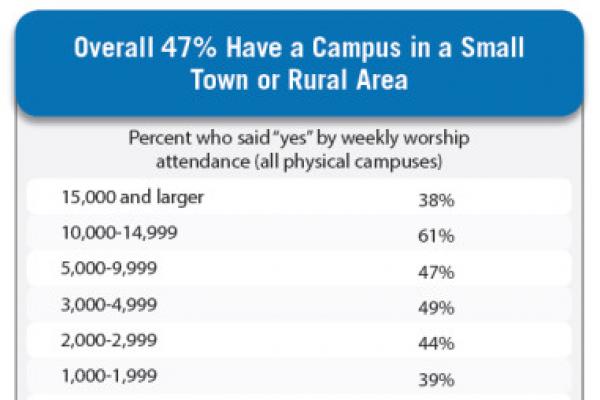The vast majority of multisite churches are growing, according to a new study, and they are seeing more involvement from lay people and newcomers after they open an additional location.
Nearly one in 10 U.S. Protestants attends a congregation with multiple campuses, according to findings released Tuesday in the “Leadership Network/Generis Multisite Church Scorecard.”
The report cites new data from the National Congregations Study, which found there were 8,000 multisite churches in the U.S. in 2012 — up from 5,000 in 2010 — including churches with more than one gathering on the same campus. Churches that have created worship space in a separate setting now exist in almost every state, several Canadian provinces, and dozens of other countries.
Multisite churches typically operate with a main campus headed by the senior minister and one or more satellite locations. In some settings, attendees at the satellite location watch the same sermon that’s beamed in from the central location but have their own dedicated on-site pastor, music, or small group meetings.
Among the findings:
- By the end of 2013, the average church has grown 14 percent since it went multisite.
- The vast majority (88 percent) report increased lay participation after having multiple locations.
- It’s still a relatively new phenomenon: 60 percent had opted for the multisite model in the last five years.
- Almost half (47 percent) have a location in a rural area or a small town.
- One in three (37 percent) started being multisite through a merger of different congregations.
Although megachurches (congregations with 2,000 or more weekly attendees) were pioneers of the multisite concept, churches with as few as 50 people and as many as 15,000 have tried this approach, said Warren Bird, director of research at Leadership Network, a Dallas-based church think tank.
The report points out some of the challenges of juggling more than one campus for worship. Researchers found in 2010 that one in 10 multisite churches they surveyed had closed a location.
In this new survey, some said rented space in public schools — popular options for multisite churches — are “one of the toughest places to launch” an additional site.
Jim Sheppard, CEO of Generis, an Atlanta-based consulting firm that sponsored the report, warned that it is important to have a “good, sound contract” in whatever location a church picks to set up a temporary worship space.
“If your initial location is a public school, don’t over estimate the relationship,” he wrote. “People can change, politics can get involved and you might be forced out sooner than expected.”
“Historically, a church’s greatest impact on the community is in its early years, and so the same thing is happening with a new campus,” Bird said.
Both independent congregations and those affiliated with denominations are embracing the multisite concept. Some regional denominational groups, including the United Methodists, consider mergers and other multisite options as part of their revitalization strategies.
“One of them is vibrant but needs facilities,” Sheppard said of some merging congregations in a webinar about the report. “The other one lacks vibrancy but has facilities.”
Adelle M. Banks writes for Religion News Service. Via RNS.
Got something to say about what you're reading? We value your feedback!
